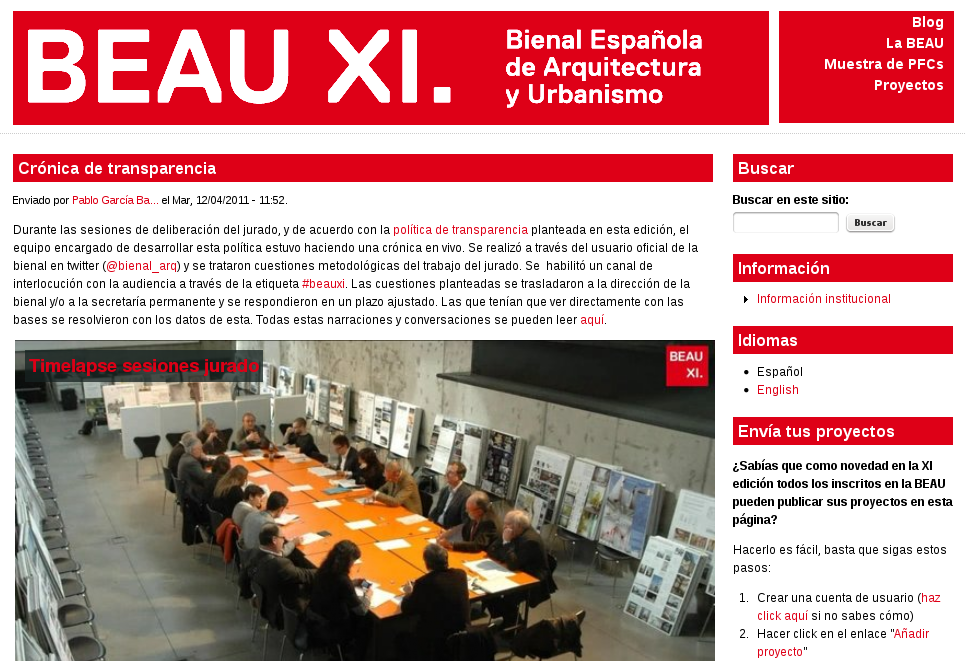'Bienal Española de Arquitectura y Urbanismo' website
 Awarded work of the architecture category. Building of 131 protected homes in Mieres, by Bernardo Angelini and David Casino
Awarded work of the architecture category. Building of 131 protected homes in Mieres, by Bernardo Angelini and David CasinoDevelopment of the official website of the 9th edition of the Spanish Biennial of Architecture and Urbanism . Although the commission was generic and succinct enough, it was also flexible enough to allow me to contribute all the ideas that I thought opportune to give an optimal response to the objectives of diffusion and documentation of the information generated about the Biennial.

The main challenge, apart from the short time to do it (initially it was only two weeks), was that besides having a platform where to publish the information of the biennial and of the relation with social networks that are demanded nowadays, it was a tool that would allow the publication and auto-publication of projects on the part of the staff of the biennial and on the part of the participants themselves without compromising the rigor that the task of documenting an event of this magnitude requires. Another aspect that I wanted to explore and incorporate was the introduction of geographic information in the form of maps.
Self-publishing and documentation
Given that the commission gave a lot of importance to the documentation work that the web had to assume, one of the aspects that would condition the success or failure of the web was that most of the 750 projects presented were published. Given that it was impossible to have a large number of works published within the time frame of the call with the available staff and resources, the only way to achieve the objective was to let the participants themselves publish the works at the same time that they provided the information to participate in the prize.
In order to make this possible, a lot of work was done to establish an easy to use and friendly protocol , which mainly passed through standardized all the fields according to what was established by the bases and criteria for generating documentary meta-information, guaranteeing the homogeneity of the submissions as well as their formal correction. What in principle was a limitation became an opportunity to generate in a relatively short time an important documentary database of works very interesting for those interested in the subject.
Geopositioning
One of the most important characteristics of an architectural work is its location, and yet this is often overlooked in many architectural websites. One of my particular obsessions as an architect and web developer is to incorporate geopositioning data so this was a great opportunity to develop some of the experiments I had been doing previously.
It is not surprising, then, that the project map occupies an important part of the project pages. All the projects are geopositioned from coordinates that are introduced from the direction, which allows to generate an interactive map that shows the winning works, finalists, selected and participants in different layers that can be activated or deactivated individually at the will of the visitor. Other outstanding interactivities are the possibility of navigating through the full-screen map (which facilitates the task of searching and finding the works and reading their relationship with the environment), change the background layers or show the information summarized of each project by going over its situation.
PFCs voting system
Another outstanding aspect of the BEAUXI website is that it is also a working tool that allows the members of the jury to vote for the Final Career Projects that are presented at the IV Muestra de PFCs for which a voting system was established that is only available to members of the jury.
Other information of interest:
- Integration with third parties: Facebook and Twitter have widgets in the sidebar that show, in real time, the activity generated in the BEAUXI channels in these social networks.
- strong>Comment moderation: as part of the transparency project, there was a possibility for anyone to vote and comment on the content published on the website. In anticipation of a misuse of the misunderstood freedom of expression, the service disqus was integrated as a tool that would allow for moderation, if necessary, of the comments by the BEAUXI. team.
- Multi-language: content and navigation can be in Spanish and English.
- Management of a common cover for all biennials that serves to see all previous editions